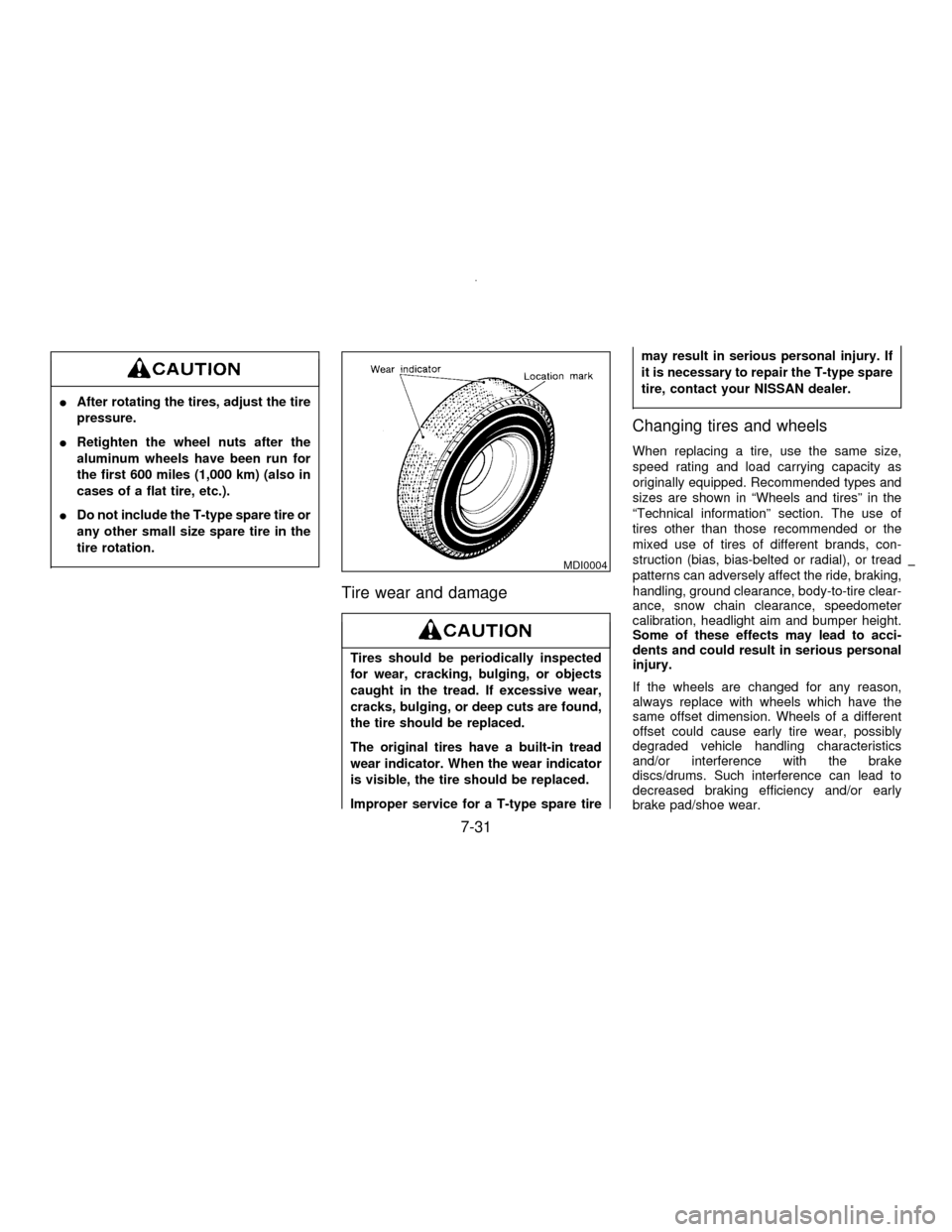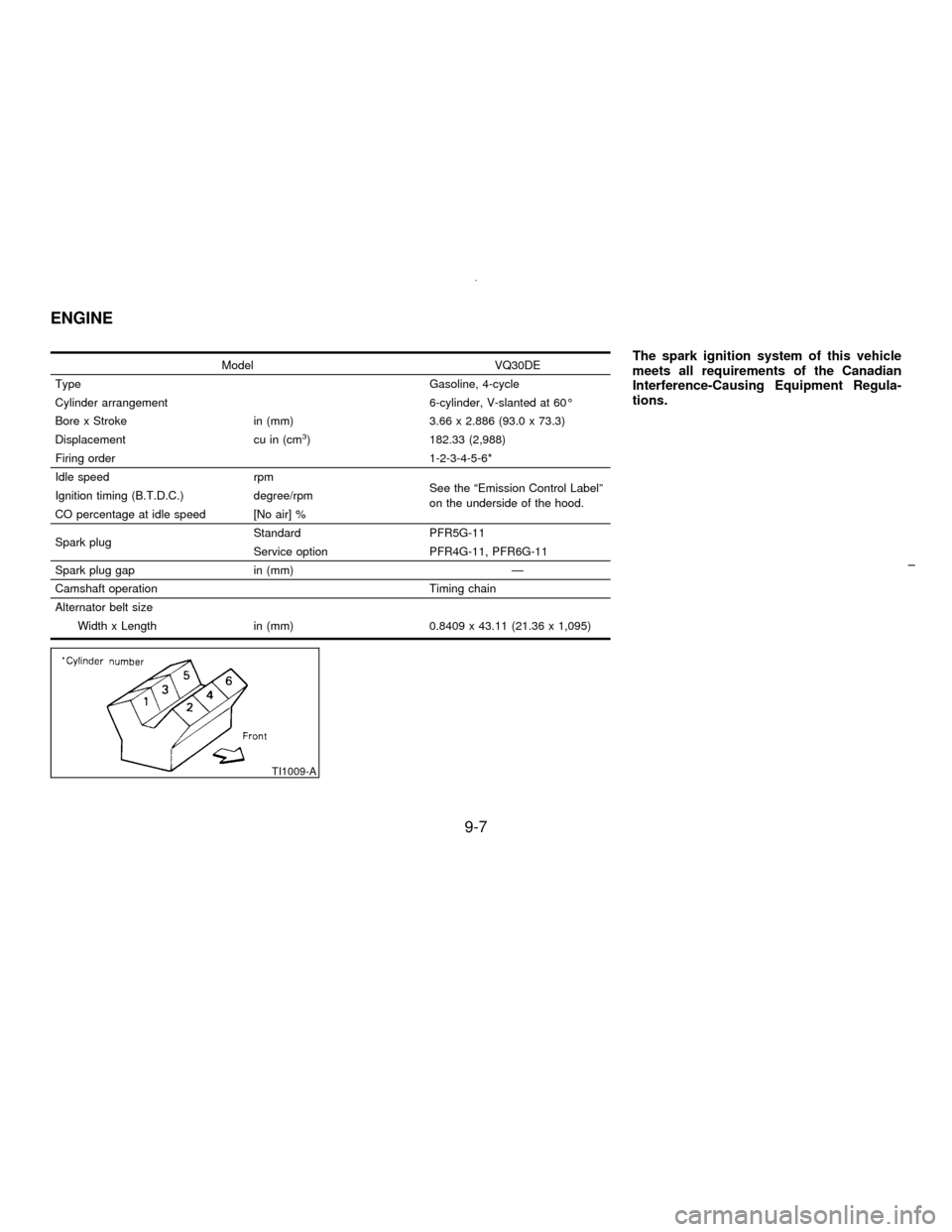1996 NISSAN MAXIMA belt
[x] Cancel search: beltPage 158 of 197

IAfter rotating the tires, adjust the tire
pressure.
IRetighten the wheel nuts after the
aluminum wheels have been run for
the first 600 miles (1,000 km) (also in
cases of a flat tire, etc.).
IDo not include the T-type spare tire or
any other small size spare tire in the
tire rotation.
Tire wear and damage
Tires should be periodically inspected
for wear, cracking, bulging, or objects
caught in the tread. If excessive wear,
cracks, bulging, or deep cuts are found,
the tire should be replaced.
The original tires have a built-in tread
wear indicator. When the wear indicator
is visible, the tire should be replaced.
Improper service for a T-type spare tiremay result in serious personal injury. If
it is necessary to repair the T-type spare
tire, contact your NISSAN dealer.
Changing tires and wheels
When replacing a tire, use the same size,
speed rating and load carrying capacity as
originally equipped. Recommended types and
sizes are shown in ªWheels and tiresº in the
ªTechnical informationº section. The use of
tires other than those recommended or the
mixed use of tires of different brands, con-
struction (bias, bias-belted or radial), or tread
patterns can adversely affect the ride, braking,
handling, ground clearance, body-to-tire clear-
ance, snow chain clearance, speedometer
calibration, headlight aim and bumper height.
Some of these effects may lead to acci-
dents and could result in serious personal
injury.
If the wheels are changed for any reason,
always replace with wheels which have the
same offset dimension. Wheels of a different
offset could cause early tire wear, possibly
degraded vehicle handling characteristics
and/or interference with the brake
discs/drums. Such interference can lead to
decreased braking efficiency and/or early
brake pad/shoe wear.
MDI0004
7-31
Z01.2.1/A32-DX
Page 165 of 197

head restraints move up and down smoothly
and that the locks (if equipped) hold securely
in all latched positions.
Seat beltsCheck that all parts of the seat belt
system (e.g. buckles, anchors, adjusters and
retractors) operate properly and smoothly, and
are installed securely. Check the belt webbing
for cuts, fraying, wear or damage.
Accelerator pedalCheck the pedal for
smooth operation and make sure the pedal
does not catch or require uneven effort. Keep
the floor mats away from the pedal.
Clutch pedal*Make sure the pedal operates
smoothly and check that it has the proper free
play.
BrakesCheck that the brakes do not pull the
vehicle to one side when applied.
Brake pedal and booster*Check the pedal
for smooth operation and make sure it has the
proper distance under it when depressed fully.
Check the brake booster function. Be sure to
keep floor mats away from the pedal.
Parking brake*Check that the lever has the
proper travel and make sure that the vehicle is
held securely on a fairly steep hill when only
the parking brake is applied.
Automatic transaxle ªParkº mechanismCheck that the brake pedal must be depressed
for the selector lever to be moved from the ªPº
position. On a fairly steep hill check that the
vehicle is held securely with the selector lever
in the ªPº position without applying any brakes.
UNDER THE HOOD AND VEHICLE
The maintenance items listed here should be
checked periodically (e.g. each time you check
the engine oil or refuel).
Windshield washer fluid*Check that there is
adequate fluid in the tank.
Engine coolant level*Check the coolant level
when the engine is cold.
Radiator and hosesCheck the front of the
radiator and clean off any dirt, insects, leaves,
etc., that may have accumulated. Make sure
the hoses have no cracks, deformation, dete-
rioration or loose connections.
Brake and clutch fluid levels*Make sure that
the brake and clutch fluid levels are between
the ªMAXº and ªMINº lines on the reservoir.
Battery*Check the fluid level in each cell. It
should be between the ªMAXº and ªMINº lines.
Engine drive belts*Make sure that no belt is
frayed, worn, cracked or oily.
Engine oil level*Check the level on thedipstick after parking the vehicle on a level
spot and turning off the engine. Be sure to wait
a few minutes to allow the oil to drain back into
the sump.
Power steering fluid level* and linesCheck
the level in the reservoir tank with the engine
off. Check the lines for proper attachment,
leaks, cracks, etc.
Automatic transaxle fluid level*Check the
level on the dipstick after putting the selector
lever in ªPº with the engine idling.
Exhaust systemMake sure there are no
loose supports, cracks or holes. If the sound of
the exhaust seems unusual or there is a smell
of exhaust fumes, immediately locate the
trouble and correct it. (See the carbon monox-
ide warning in the ªStarting and drivingº sec-
tion)
UnderbodyThe underbody is frequently ex-
posed to corrosive substances such as those
used on icy roads or to control dust. It is very
important to remove these substances, other-
wise rust will form on the floor pan, frame, fuel
lines and around the exhaust system. At the
end of winter, the underbody should be thor-
oughly flushed with plain water, being careful
to clean those areas where mud and dirt may
accumulate. See the ªAppearance and interior
careº section for additional information.
8-4
Z01.2.1/A32-DX
Page 167 of 197
![NISSAN MAXIMA 1996 A32 / 4.G Owners Manual SCHEDULE 1
Abbreviations: R = Replace I = Inspect. Correct or replace if necessary. [ ]: At the mileage intervals only
MAINTENANCE OPERATIONMAINTENANCE INTERVAL
Perform at number of miles,
kilometers NISSAN MAXIMA 1996 A32 / 4.G Owners Manual SCHEDULE 1
Abbreviations: R = Replace I = Inspect. Correct or replace if necessary. [ ]: At the mileage intervals only
MAINTENANCE OPERATIONMAINTENANCE INTERVAL
Perform at number of miles,
kilometers](/manual-img/5/596/w960_596-166.png)
SCHEDULE 1
Abbreviations: R = Replace I = Inspect. Correct or replace if necessary. [ ]: At the mileage intervals only
MAINTENANCE OPERATIONMAINTENANCE INTERVAL
Perform at number of miles,
kilometers or months, which-
ever comes first.Miles x 1,000 3.75 7.5 11.25 15 18.75 22.5 26.25 30 33.75 37.5 41.25 45 48.75 52.5 56.25 60
(km x 1,000) (6) (12) (18) (24) (30) (36) (42) (48) (54) (60) (66) (72) (78) (84) (90) (96)
Months 3 6 9 12 15 18 21 24 27 30 33 36 39 42 45 48
Emission control system maintenanceDrive belts See NOTE (1)I*
Air cleaner filter See NOTE (2) [R] [R]
Vapor linesI* I*
Fuel linesI* I*
Fuel filter See NOTE (3)*
Engine coolant See NOTE (4)R*
Engine oilRRRRRRRRRRRRRRRR
Engine oil filter (Use part No. 15208-31U00 or equivalent)RRRRRRRRRRRRRRRR
Spark plugs (Use PLATINUM-TIPPED type)[R]
Intake & exhaust valve clearance See NOTE (5)
NOTE: (1) After 60,000 miles (96,000 km) or 48 months, inspect every 15,000 miles (24,000 km) or 12 months.
(2) If operating mainly in dusty conditions, more frequent maintenance may be required.
(3) If vehicle is operated under extremely adverse weather conditions or in areas where ambient temperatures are either
extremely low or extremely high, the filters might become clogged. In such an event, replace them immediately.
(4) After 60,000 miles (96,000 km) or 48 months, replace every 30,000 miles (48,000 km) or 24 months.
(5) If valve noise increases, inspect valve clearance.
(6) Maintenance items and intervals with ª*º are recommended by NISSAN for reliable vehicle operation. The owner need not
perform such maintenance in order to maintain the emission warranty or manufacturer recall liability. Other maintenance
items and intervals are required.
8-6
Z01.2.1/A32-DX
Page 169 of 197
![NISSAN MAXIMA 1996 A32 / 4.G Owners Manual SCHEDULE 2
Abbreviations: R = Replace I = Inspect. Correct or replace if necessary. [ ]: At the mileage intervals only
MAINTENANCE OPERATIONMAINTENANCE INTERVAL
Perform at number of miles, kilometers
NISSAN MAXIMA 1996 A32 / 4.G Owners Manual SCHEDULE 2
Abbreviations: R = Replace I = Inspect. Correct or replace if necessary. [ ]: At the mileage intervals only
MAINTENANCE OPERATIONMAINTENANCE INTERVAL
Perform at number of miles, kilometers](/manual-img/5/596/w960_596-168.png)
SCHEDULE 2
Abbreviations: R = Replace I = Inspect. Correct or replace if necessary. [ ]: At the mileage intervals only
MAINTENANCE OPERATIONMAINTENANCE INTERVAL
Perform at number of miles, kilometers
or months, whichever comes first.Miles x 1,000 7.5 15 22.5 30 37.5 45 52.5 60
(km x 1,000) (12) (24) (36) (48) (60) (72) (84) (96)
Months 6 12 18 24 30 36 42 48
Emission control system maintenance
Drive belts See NOTE (1)I*
Air cleaner filter[R] [R]
Vapor linesI* I*
Fuel linesI* I*
Fuel filter See NOTE (2)*
Engine coolant See NOTE (3)R*
Engine oilRRRRRRRR
Engine oil filter (Use part No. 15208-31U00 or equivalent)RRRRRRRR
Spark plugs (Use PLATINUM-TIPPED type)[R]
Intake & exhaust valve clearance See NOTE (4)
NOTE: (1) After 60,000 miles (96,000 km) or 48 months, inspect every 15,000 miles (24,000 km) or 12 months.
(2) If vehicle is operated under extremely adverse weather conditions or in areas where ambient temperatures are either
extremely low or extremely high, the filters might become clogged. In such an event, replace them immediately.
(3) After 60,000 miles (96,000 km) or 48 months, replace every 30,000 miles (48,000 km) or 24 months.
(4) If valve noise increases, inspect valve clearance.
(5) Maintenance items and intervals with ª*º are recommended by NISSAN for reliable vehicle operation. The owner need not
perform such maintenance in order to maintain the emission warranty or manufacturer recall liability. Other maintenance
items and intervals are required.
8-8
Z01.2.1/A32-DX
Page 171 of 197

EXPLANATION OF MAINTENANCE
ITEMS
Additional information on the following
items with ª*º is found in the ªDo-it-
yourself operationsº section.
Emission control system
maintenance
Drive belts*Check drive belts for wear, fray-
ing or cracking and also for proper tension.
Replace the drive belts if found damaged.
Air cleaner filterUnder normal driving condi-
tions, the air cleaner filter should be replaced
in accordance with the maintenance schedule.
However, driving the vehicle in dusty areas
may cause more rapid clogging of the element.
Consequently, the element may have to be
replaced more frequently.
Vapor linesCheck vapor lines and connec-
tions for failure or looseness. If leaks are
found, replace them.
Fuel linesCheck the fuel hoses, piping and
connections for leaks, looseness or deteriora-
tion. Replace any parts if they are damaged.
Fuel filterIf the vehicle is operated under
extremely adverse weather conditions or in
areas where ambient temperatures are either
extremely low or extremely high, the filtermight become clogged. In such an event,
replace the filter immediately.
Engine coolant*Drain and flush the cooling
system.
Engine oil & oil filter*Under normal driving
conditions, the engine oil and oil filter should
be replaced in accordance with the mainte-
nance schedule. However, under severe driv-
ing conditions, they may have to be replaced
more frequently.
Spark plugs*Replace with new plugs having
the correct heat range.
Intake & exhaust valve clearanceCheck and
adjust the valve clearance.
Chassis and body maintenance
Brake lines & cablesCheck the brake lines
and hoses (including brake booster vacuum
hoses, connections & check valve) and park-
ing brake cables for proper attachment, leaks,
cracks, chafing, abrasion, deterioration, etc.
Brake pads, discs, drums & liningsCheck
these and the other neighboring brake compo-
nents for wear, deterioration and leaks. Under
severe driving conditions, they may have to be
inspected more frequently.
Manual & automatic transaxle gear oil*Check the oil level and visually inspect for
signs of leakage.
Under severe driving conditions, the oil should
be replaced at the specified interval.
Steering gear & linkage, axle & suspension
parts, and drive shaft bootsCheck for dam-
age, looseness and leakage of oil or grease.
Under severe driving conditions, more fre-
quent inspection should be performed.
Steering linkage ball joints & front suspen-
sion ball jointsCheck the ball joints for dam-
age, looseness and grease leakage.
Exhaust systemVisually check the exhaust
pipes, muffler, and hangers for proper attach-
ment, leaks, cracks, chafing, abrasion, dete-
rioration, etc. Under severe driving conditions,
inspection should be performed more fre-
quently.
Air bag systemCheck the air bag system
components for proper attachment, damage,
deformities, cracks rust, etc. Work around and
on the air bag system should be done by an
authorized NISSAN dealer.
8-10
Z01.2.1/A32-DX
Page 178 of 197

Model VQ30DE
Type Gasoline, 4-cycle
Cylinder arrangement 6-cylinder, V-slanted at 60É
Bore x Stroke in (mm) 3.66 x 2.886 (93.0 x 73.3)
Displacement cu in (cm
3) 182.33 (2,988)
Firing order 1-2-3-4-5-6*
Idle speed rpm
See the ªEmission Control Labelº
on the underside of the hood. Ignition timing (B.T.D.C.) degree/rpm
CO percentage at idle speed [No air] %
Spark plugStandard PFR5G-11
Service option PFR4G-11, PFR6G-11
Spark plug gap in (mm) Ð
Camshaft operation Timing chain
Alternator belt size
Width x Length in (mm) 0.8409 x 43.11 (21.36 x 1,095)
The spark ignition system of this vehicle
meets all requirements of the Canadian
Interference-Causing Equipment Regula-
tions.
TI1009-A
ENGINE
9-7
Z01.2.1/A32-DX
Page 183 of 197

threads behind the finisher, apply only light
pressure to the drill.
2. Mount the license plate bracket.
3. Mount the license plate with the 0.24 in (6
mm) bolts. The bolts used to fasten the
license plate to the bracket are not included
in the attaching hardware that comes with
the bracket.
IIt is extremely dangerous to ride in a
cargo area inside of a vehicle. In a
collision, people riding in these areas
are more likely to be seriously injured
or killed
IDo not allow people to ride in any
area of your vehicle that is not
equipped with seats and seat belts.
IBe sure everyone in your vehicle is in
a seat and using a seat belt properly.
Terms
It is important to familiarize yourself with the
following terms before loading your vehicle:
ICurb Weight (actual weight of your vehicle)
- vehicle weight including: standard and
optional equipment, fluids, emergency
tools, and spare tire assembly. This weight
does notinclude passengers and cargo.
IGVW (Gross Vehicle Weight) - curb weight
plus the combined weight of passengers
and cargo.IGVWR (Gross Vehicle Weight Rating) -
maximum total weight (load) limit specified
for the vehicle.
IGAWR (Gross Axle Weight Rating) - maxi-
mum weight (load) limit specified for the
front or rear axle.
Determining vehicle load capacity
The load capacity of this vehicle is determined
by weight, not by available cargo space. For
example, a luggage rack, bike carrier, cartop
carrier or similar equipment does not increase
load carrying capacity of your vehicle.
To determine vehicle load capacity:
Vehicle weight can be determined by using a
commercial-grade scale, found at places such
as a truck stop, gravel quarry, grain elevator,
or a scrap metal recycling facility.
1) Determine the curb weight of your vehicle.
2) Compare the curb weight amount to the
GVWR specified for your vehicle to deter-
mine how much more weight your vehicle
can carry.
3) After loading (cargo and passengers), re-
weigh your vehicle to determine if either
GVWR or GAWR for your vehicle is ex-
ceeded. If GVWR is exceeded, remove
cargo as necessary. If either the front or
VEHICLE LOADING
INFORMATION
9-12
Z01.2.1/A32-DX
Page 192 of 197

10 Index
A
Air bag warning light ....................................... 2-21
Air cleaner filter ............................................... 7-16
Air conditioner
Air conditioner operation ............................. 3-5
Air conditioner specification label.............. 9-11
Automatic air conditioner............................. 3-9
Air flow chart ..................................................... 3-6
AM-FM radio with cassette player .................. 3-12
AM-FM radio with cassette player and compact
disc player (Bose audio system) .................... 3-16
Antenna........................................................... 3-22
Anti-lock brake system ................................... 4-17
Automatic
Automatic air conditioner............................. 3-9
Automatic transmission fluid ....................... 7-9
Driving with automatic transmission............ 4-6
Avoiding collision and rollover .......................... 4-3
B
Battery............................................................. 7-12
Battery replacement.......................................... 2-7
Before starting the engine ................................ 4-6
Brake
Anti-lock brake system .............................. 4-17
Brake and clutch fluid................................ 7-11
Brake booster ............................................ 7-20Brake pedal ............................................... 7-19
Brake wear indicators ........................ 1-8, 7-19
Parking brake ................................... 4-11, 7-18
Break-in schedule ........................................... 4-13
C
Capacities and recommended fuel/lubricants... 9-2
Caution and warning labels ............................ 2-21
CB radio or car phone .................................... 3-23
Changing
Changing engine coolant ............................ 7-5
Changing engine oil .................................... 7-7
Changing oil filter ........................................ 7-8
Checking engine coolant level .......................... 7-4
Checking engine oil level .................................. 7-6
Child restraints for infants and small children .... 2-
29
Child safety ..................................................... 2-23
Child safety rear door lock................................ 2-3
Cigarette lighter and ash trays ....................... 1-17
Cleaning exterior and interior ........................... 6-2
Clock ............................................................... 1-21
Clutch pedal .................................................... 7-20
Cold weather driving cautions ........................ 4-18
Compact disc (CD) player operation .............. 3-21
Controls............................................................. 3-3
Coolant
Changing engine coolant ............................ 7-5
Checking engine coolant level .................... 7-4Engine coolant temperature gauge ............. 1-4
Cornering light ................................................ 1-14
Corrosion protection ......................................... 6-5
Cruise control.................................................. 4-12
Cup and card holders ..................................... 1-18
DDefogger switch
Rear window and outside mirror defogger
switch......................................................... 1-12
Dimensions and weights ................................... 9-8
Door lock operation .......................................... 2-6
Door locks ......................................................... 2-2
Door unlock operation ...................................... 2-6
Drinking alcohol/drugs and driving ................... 4-4
Drive belts ....................................................... 7-13
Driving
Cold weather driving cautions ................... 4-18
Drinking alcohol/drugs and driving .............. 4-4
Driving with automatic transmission............ 4-6
Driving with manual transmission ............... 4-9
Precautions when driving .......................... 4-16
Precautions when starting and driving ........ 4-2
E
Economy hints ................................................ 4-14
Emission control information label .................. 9-10
Emission control system warranty .................. 9-18
Z01.2.1/A32-DX